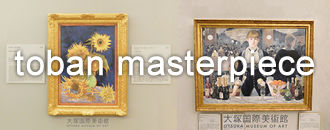◀Reproduction of Takamatsuzuka Tumulus Mural - The "Asuka Beauties" come vividly to life (Part 1)
Vivid and wet colors, dampness of the wall surface... “Memory of the time of discovery”
Simultaneously with the expression of unevenness, we also studied with experts the colors and textures of the Takamatsuzuka Tumulus murals at the time of their discovery.
What were the colors of the murals 48 years ago?
“The inside of the stone chamber at that time was extremely humid, and it seemed to reflect the light.”
“It was as if the murals were sweating.”
“The plaster was in good condition in some areas and bad in others.”
The vividness of the wet colors and the rough look of the plaster...
The experts remembered vividly what the murals looked like at the time of their discovery, almost half a century later.
Based on the memories of the experts, we made a number of prototypes and held meetings with them to reflect the expressions on the walls that could not be seen (or conveyed) only through data and photographs in this production.
 ▲After many prototypes, the experts compared and discussed in detail and shared their opinions.
▲After many prototypes, the experts compared and discussed in detail and shared their opinions. 
Searching for colors based on "Data" and "Memories" from the time of discovery.
For the production of this project, we were specially provided with the image data of two shots, a full view of the women's group and a close-up, which were taken by the cooperation of “Benrido” company when the mural was first discovered in 1972. While examining the image data in detail, we will correct the scratched areas on the film. The image data and the newly measured 3D data are then combined, checked for distortions, and adjusted.
The image is then decomposed into four CMYK (blue, red, yellow, and black) colors (color decomposition) to create the original data for the transfer paper. [Photo 1]
▲ [Photo 1] Image data is broken down into four CMYK colors. Color decomposition is performed while assuming the color tones of the ceramic board, and the original data for the transfer paper is created.
Basically, the coloring of the ceramic paint will not be known until it is fired. Assuming that the final color will be the same as the original, we make detailed adjustments by comparing it to a printed sample of the color tone of the mural painting at the time of its discovery.
The final color is then silk-screened using special paints for ceramics, and a transfer paper is created. [Photo 2]
The transfer paper is then pasted onto a ceramic board that has been fired once to reproduce only the unevenness of the surface. [Photo 3]
The ceramic board with the transfer paper applied is fired again to check the degree of color reproduction. To reproduce colors that cannot be expressed by the transfer paper alone, the technician further supplements the colors. [Photo 4]
 ▲ [Photo 2] Silkscreen printing using ceramic paints to make transfer paper.
▲ [Photo 2] Silkscreen printing using ceramic paints to make transfer paper. ▲ [Photo 3] The transfer paper is pasted onto a ceramic board that reproduces only the unevenness of the surface. The paper is carefully attached to the ceramic board so that the unevenness of the plate and the transfer paper do not shift, and so that the paper does not tear due to the unevenness of the plate.
▲ [Photo 4] The color difference in the women’s skirt, which could not be seen in the print, was expressed by using complementary colors based on the advice of the experts.
“The skirt of the women in red is not all blue, but blue and purple. The photo doesn't print well, but the ceramic board should reflect that color difference.” “The yellow color at that time was a lemon yellow.” “The paints used in those days must not have contained yellow.”
We received valuable opinions that only experts could have known, and we made many attempts to "reproduce the colors as they were at the time of the discovery" by making complementary color adjustments. [Photo 5]
 ▲ [Photo 5] Based on image data, target color data, and the opinions of experts, we aim to reproduce the colors used when the mural was discovered.
▲ [Photo 5] Based on image data, target color data, and the opinions of experts, we aim to reproduce the colors used when the mural was discovered.
“The experts discussed the key points to reproduce the original color and texture of the wall paintings on ceramic boards, as each of them had a different impression of the wall paintings at different times. However, it was difficult to reproduce the colors as intended, and if we focused only on reproducing the colors of the key areas, the overall impression would be lost, so we struggled to reproduce the colors and textures while maintaining a balance between the whole and the areas." (Employee in charge)
Asuka Beauties" vividly revived
The resulting ceramic boards were finished with an accuracy of less than 1 mm in unevenness expression, and the experts commented, "It is very vivid. It is very close to the impression I had when I was looking at it. It's impossible to talk with the real thing while touching it." "Next time, I would like to see the entire mural on a ceramic board."
 ▲Prototype without correction
▲Prototype without correction  ▲The completed replica ceramic board. Based on the advice of experts, we reproduced the colors when the mural was discovered, including the lemon yellow hue, the color of the Asuka beauties' clothes, the wet color, and the expression of the particles of plaster and paint.
▲The completed replica ceramic board. Based on the advice of experts, we reproduced the colors when the mural was discovered, including the lemon yellow hue, the color of the Asuka beauties' clothes, the wet color, and the expression of the particles of plaster and paint.
At the press conference, Dr. Masanori Aoyagi, Director of the Archaeological Institute of Kashihara, said, “Reproductions on ceramic boards can be preserved in the same condition when they were found, and can also be made available to the public.” “For cultural properties that are inevitably subject to deterioration, replacing them with ceramic boards is a major defensive measure. The ceramic replicas will have a significant impact on the history of cultural properties.” Our ceramic replica received a high evaluation from him.
 ▲The replica of the ceramic board was unveiled at a press conference on March 27, 2020. (Left: Dr. Masanori Aoyagi, Director, Archaeological Institute of Kashihara, Nara Prefecture; Right: Eitsugu Osugi, President, Otsuka Ohmi Ceramics Co., Ltd.)
▲The replica of the ceramic board was unveiled at a press conference on March 27, 2020. (Left: Dr. Masanori Aoyagi, Director, Archaeological Institute of Kashihara, Nara Prefecture; Right: Eitsugu Osugi, President, Otsuka Ohmi Ceramics Co., Ltd.)
New Possibilities Created by Replacing Valuable Cultural Properties with Ceramic Boards
In March 2020, under the supervision of the Agency for Cultural Affairs, the restoration of the Takamatsuzuka Tumulus murals was successfully completed thanks to the efforts of restoration technicians and related personnel. However, since the original was painted on plaster, which is prone to deterioration, it is difficult to exhibit the paintings in the permanent collection.
Under such circumstances, the "ceramic boards" reproduced from the "records" preserved 48 years ago and the "memories" of the experts could also be a valuable presence that conveys the appearance of the mural paintings at the time of their discovery.
The "Ceramic Archive" not only records the "now" of cultural properties, but also revives their past and continues to pass them on to future generations. We see new possibilities for replication using ceramic boards.



